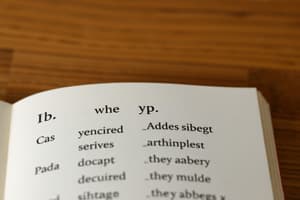Podcast
Questions and Answers
What is the primary function of 'to have' when it acts as a main verb?
What is the primary function of 'to have' when it acts as a main verb?
- To express necessity
- To form questions
- To create complex tenses
- To indicate possession or ownership (correct)
Which of the following sentences correctly uses 'to have' as an auxiliary verb?
Which of the following sentences correctly uses 'to have' as an auxiliary verb?
- I have a dog.
- She has a new idea.
- He has breakfast at eight.
- We have finished our homework. (correct)
Which form of 'to have' is used in the sentence: 'They _____ a great time at the party'?
Which form of 'to have' is used in the sentence: 'They _____ a great time at the party'?
- has
- having
- had
- have (correct)
What does 'to have' express when used as a modal verb?
What does 'to have' express when used as a modal verb?
What is the base form of the verb 'to have'?
What is the base form of the verb 'to have'?
What is the correct affirmative form of 'to have' for the pronoun 'she' in the present tense?
What is the correct affirmative form of 'to have' for the pronoun 'she' in the present tense?
How do you form the negative of 'to have' in the present tense for 'he'?
How do you form the negative of 'to have' in the present tense for 'he'?
Which sentence correctly uses the past form of 'to have'?
Which sentence correctly uses the past form of 'to have'?
What is the past participle form of the verb 'to have'?
What is the past participle form of the verb 'to have'?
Which of the following sentences uses the continuous form of 'to have' correctly?
Which of the following sentences uses the continuous form of 'to have' correctly?
Flashcards are hidden until you start studying
Study Notes
Uses of the Verb "To Have"
- Serves as a main verb indicating possession or action (e.g., "I have a bike").
- Functions as an auxiliary verb to form complex tenses, without having a specific meaning.
- Acts as a modal verb to express necessity or obligation.
Forms of the Verb "To Have"
- Irregular verb with different forms for present, past, and past participle.
Base Form
- Base form is "have".
- Used in imperative sentences and forming the infinitive (e.g., "Have a piece of cake!", "to have").
Present Tense
- Present form includes "have" or "has", depending on the subject.
- Affirmative forms:
- I have
- You have
- He/She/It has
- We/They/You have
- Negative forms use "do":
- I don’t have
- You don’t have
- He/She/It doesn’t have
- We/They/You don’t have
Past Tense
- Past form is "had" for all subjects.
- Affirmative forms:
- I had
- You had
- He/She/It had
- We/They/You had
- Negative forms still use "do":
- I didn’t have
- You didn’t have
- He/She/It didn’t have
- We/They/You didn’t have
Past Participle
- Past participle is also "had"; used in perfect tenses and passive voice.
- Context differentiates between past and past participle usages.
Continuous Form
- Continuous form is "having"; used in continuous tenses.
- Examples:
- I am having
- You are having
- He/She/It is having
- We/They/You are having
"To Have" as an Auxiliary Verb
- Forms perfect tenses alongside other verbs.
- Present and past forms can use contractions in informal speech.
- Affirmative contractions in present:
- I’ve (I have)
- You’ve (You have)
- He’s/She’s/It’s (He/She/It has)
- We’ve/They’ve/You’ve (We/They/You have)
Studying That Suits You
Use AI to generate personalized quizzes and flashcards to suit your learning preferences.



